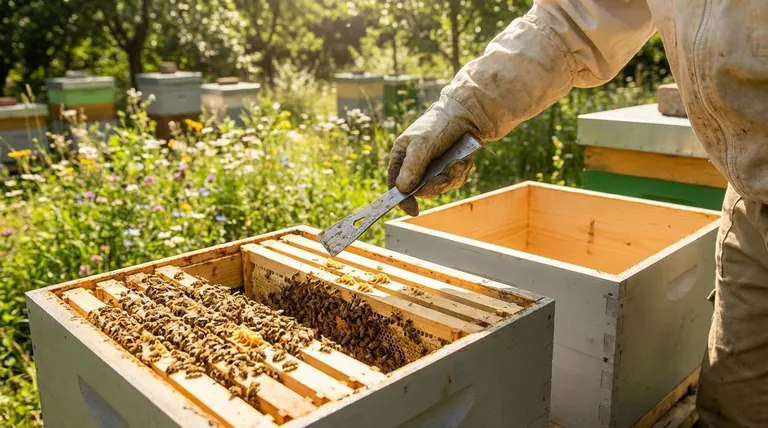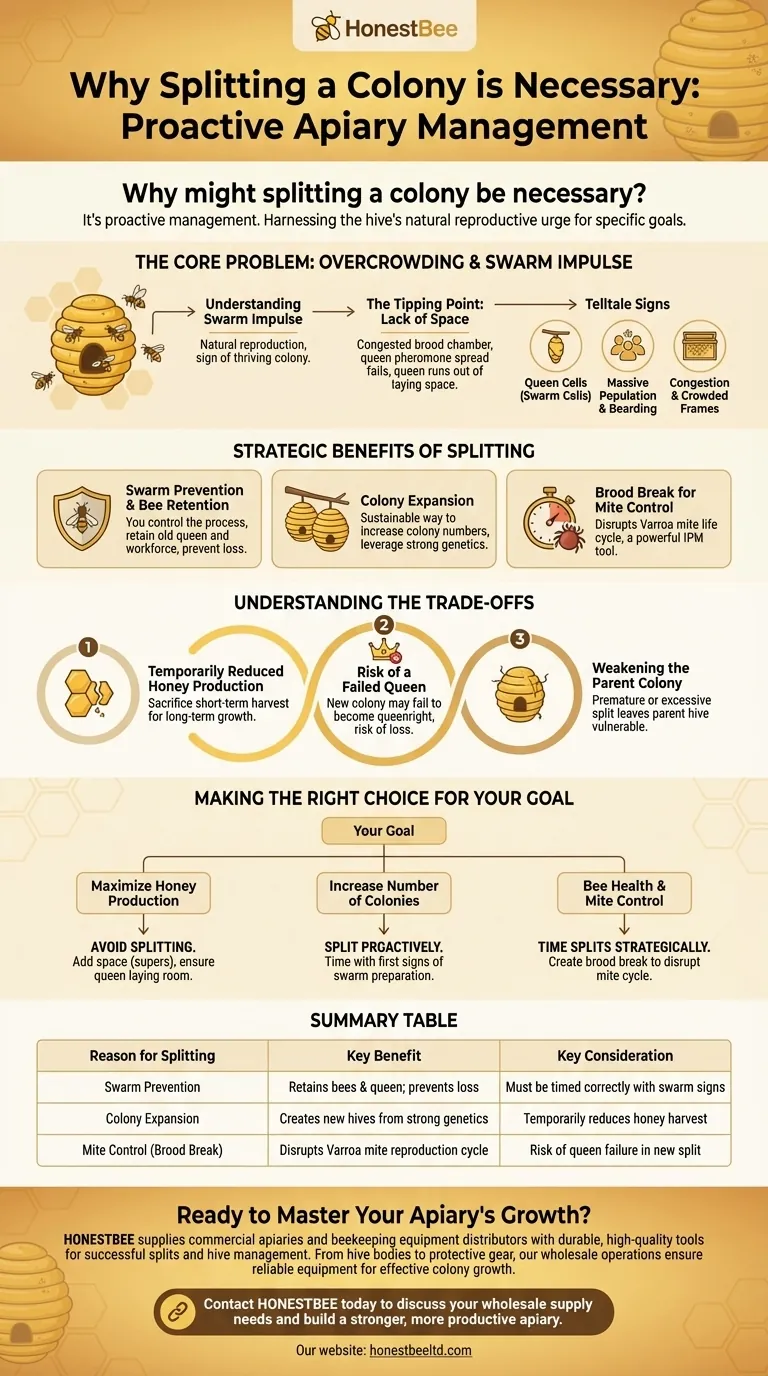At its core, splitting a honeybee colony is a proactive management technique. It is performed when a hive becomes so populous that it runs out of space, a condition that triggers its natural instinct to reproduce by swarming. The beekeeper intentionally divides one oversized colony into two smaller, manageable ones.
Splitting is not about fixing a problem; it's about channeling a colony's success. You are harnessing the hive's natural reproductive urge to swarm and redirecting it to achieve specific goals, such as preventing the loss of your bees and expanding your apiary.

The Core Problem: Overcrowding and the Urge to Swarm
A strong, successful colony will inevitably outgrow its living space. Understanding this natural cycle is the key to knowing when and why a split is necessary.
Understanding the Swarm Impulse
Swarming is the natural method honeybee colonies use to reproduce. It is not a sign of a failing hive; on the contrary, it is a sign of a thriving, healthy colony that has successfully grown its population.
The process involves the old queen leaving with roughly half the worker bees to establish a new home. The original hive is left with a new, virgin queen to continue the colony.
The Tipping Point: Lack of Space
The primary trigger for the swarm impulse is overcrowding. When the brood chamber becomes congested with bees, pollen, nectar, and developing brood, the queen's pheromones are not distributed as effectively.
This signals to the colony that it's time to divide. More importantly, the queen physically runs out of empty cells in which to lay eggs, halting the colony's growth and initiating swarm preparations.
Telltale Signs of an Impending Swarm
A beekeeper can observe several key indicators that a hive is preparing to swarm. The most definitive sign is the presence of queen cells, also known as swarm cells, which look like peanut shells hanging from the bottom or face of the comb.
Other signs include a massive population of bees, with bees "bearding" on the outside of the hive entrance on warm evenings, and a general sense of congestion on every frame within the hive.
Strategic Benefits of Splitting a Hive
While preventing the loss of bees is the immediate goal, splitting offers several strategic advantages for the beekeeper.
Swarm Prevention and Bee Retention
This is the most critical benefit. When a colony swarms, you lose your old queen and up to 60% of your workforce. By splitting the colony yourself, you control the process and retain those valuable bees, preventing them from ending up in a neighbor's tree.
Colony Expansion
Splitting is the most common and sustainable way to increase the number of colonies in your apiary. You are essentially creating a new hive using the resources and genetics of your strongest performers.
Brood Break for Mite Control
A well-timed split can create a "brood break"—a period where there are no capped cells for pests like Varroa mites to reproduce in. This disrupts the mite's life cycle, serving as a powerful tool in an integrated pest management plan.
Understanding the Trade-offs
Splitting is a powerful tool, but it is not without its costs and risks. It is a decision that requires careful timing and an understanding of the potential downsides.
Temporarily Reduced Honey Production
The most significant trade-off is a decrease in the current season's honey harvest. A single, powerful colony will gather far more nectar than two smaller, newly-split colonies. By splitting, you sacrifice short-term honey production for long-term apiary growth.
Risk of a Failed Queen
A successful split depends on the new colony becoming "queenright." This means either the bees must successfully raise a new queen who mates and returns, or they must accept a queen you introduce. There is always a risk this process will fail, leading to a doomed, queenless colony that will perish without intervention.
Weakening the Parent Colony
If a split is performed too early in the season, or if too many resources (bees and brood) are removed, the original parent colony can be left too weak. This makes it vulnerable to pests, diseases, or robbing by other bees, and it may struggle to build back its population.
Making the Right Choice for Your Goal
Deciding whether and when to split your colony depends entirely on your objectives as a beekeeper.
- If your primary focus is maximizing honey production this season: Avoid splitting if possible. Instead, manage swarm pressure by adding more space (supers) and ensuring the queen has room to lay.
- If your primary focus is increasing your number of colonies: Split your hives proactively as soon as they are strong enough and show the first signs of swarm preparation.
- If your primary focus is bee health and mite control: Time your splits to create a strategic brood break, disrupting the Varroa mite life cycle before pest populations can explode in late summer.
Ultimately, splitting transforms you from a passive bee-haver into an active beekeeper, guiding your colonies' natural instincts toward sustainable growth.
Summary Table:
| Reason for Splitting | Key Benefit | Key Consideration |
|---|---|---|
| Swarm Prevention | Retains bees & queen; prevents loss | Must be timed correctly with swarm signs |
| Colony Expansion | Creates new hives from strong genetics | Temporarily reduces honey harvest |
| Mite Control (Brood Break) | Disrupts Varroa mite reproduction cycle | Risk of queen failure in new split |
Ready to Master Your Apiary's Growth?
Splitting colonies is a core skill for sustainable beekeeping. HONESTBEE supplies commercial apiaries and beekeeping equipment distributors with the durable, high-quality tools needed for successful splits and hive management.
From hive bodies and frames to protective gear, our wholesale-focused operations ensure you have the reliable equipment to guide your colonies' growth effectively.
Contact HONESTBEE today to discuss your wholesale supply needs and build a stronger, more productive apiary.
Visual Guide

Related Products
- HONESTBEE Advanced Ergonomic Stainless Steel Hive Tool for Beekeeping
- Professional Dual-End Stainless Steel Hive Tool for Beekeeping
- Wooden Bee Brush with Triple Row Artificial Fiber for Beekeeping
- Yellow Plastic Bucket Pail Perch for Beekeeping
- No Grafting Queen Rearing Kit: System for Royal Jelly Production and Queen Rearing
People Also Ask
- What is the hole in a hive tool for? A Multi-Tool for Apiary Repairs and Maintenance
- How is a hive tool used for scraping and cleaning? Master Hive Maintenance for a Healthy Colony
- What is a hive tool and what are its uses? Master Your Hive Inspections with the Essential Beekeeper's Tool
- Why is it important to compare the progress of different hives? A Beekeeper's Key Diagnostic Tool
- How should beekeepers handle bees when using a hive tool? Master Calm, Deliberate Techniques



















